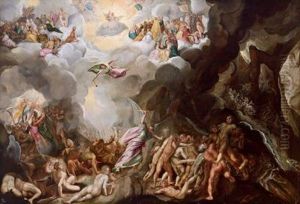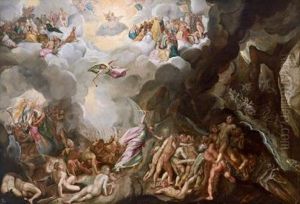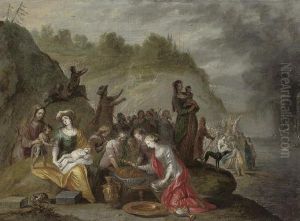Michiel Congnet Paintings
Michiel Congnet, a somewhat elusive figure in the annals of art history, was a Flemish painter born in 1538, whose life and work are less documented than those of his contemporaries. Despite the scarcity of records, Congnet is known to have been an active artist during the late 16th century, a period rich in cultural and artistic evolution in Europe. His contributions, though not as widely recognized as those of his peers, offer valuable insights into the Flemish art scene of the time.
Congnet's artistic journey is believed to have begun in his native Flanders, where he would have been exposed to the burgeoning Northern Renaissance movement. This period was marked by a keen interest in realism, detailed landscapes, and religious themes, all of which are echoed in the fragments of Congnet's work that survive. While specific details of his training remain a mystery, it is likely that he apprenticed under a master in the Flemish tradition, honing a craft deeply rooted in the meticulous observation of nature and human emotion.
Throughout his career, Michiel Congnet's work was indicative of the shifting tastes of the era, moving perhaps from the detailed devotional pieces characteristic of early Flemish painting towards the more mannerist influences that swept through Europe in the latter half of the 16th century. His paintings, few of which are firmly attributed to him today, exhibit a keen attention to detail and a vibrant use of color that was typical of the Flemish style.
Despite the scant documentary evidence of Congnet's life, it is clear that he was part of the vibrant artistic milieu of his time. Records suggest he may have traveled within Europe, as was common for artists of his period seeking patronage and inspiration. These journeys would have exposed him to a variety of influences, further enriching his work.
Michiel Congnet's death in 1599 marked the end of an enigmatic yet fruitful career. While he may not have achieved the fame of contemporaries like Pieter Bruegel the Elder or Hans Holbein, his work contributes to our understanding of the diverse and dynamic world of Flemish Renaissance art. Today, scholars continue to piece together his legacy, searching for lost works and re-evaluating those paintings tentatively attributed to him, in an effort to fully appreciate his contribution to the art historical canon.



